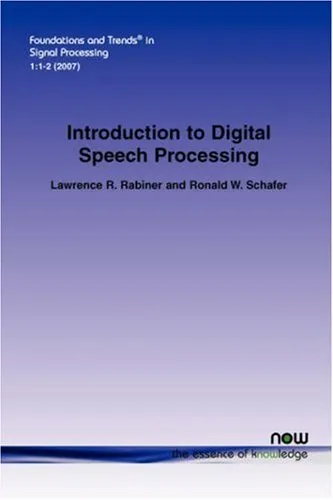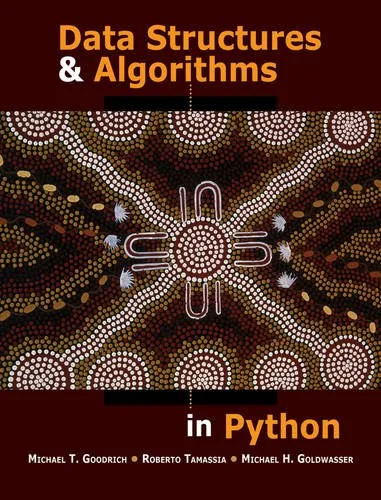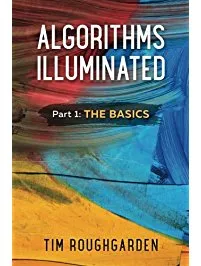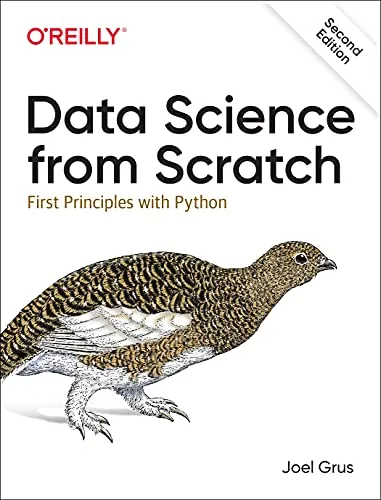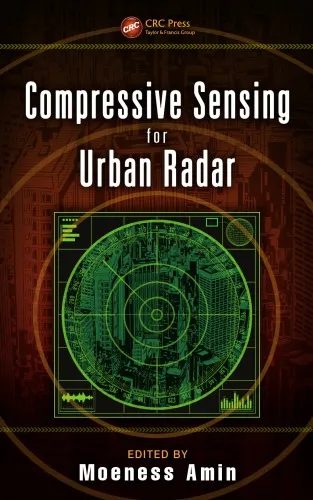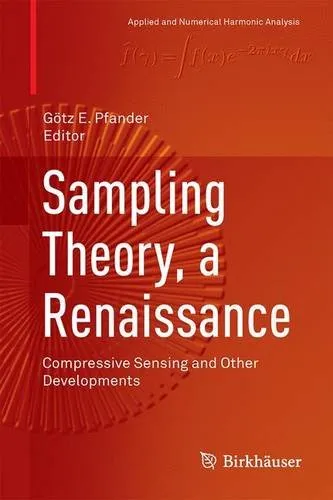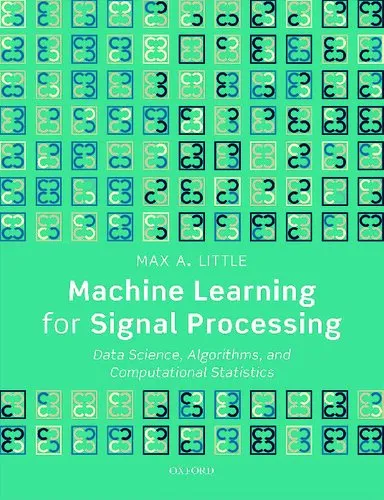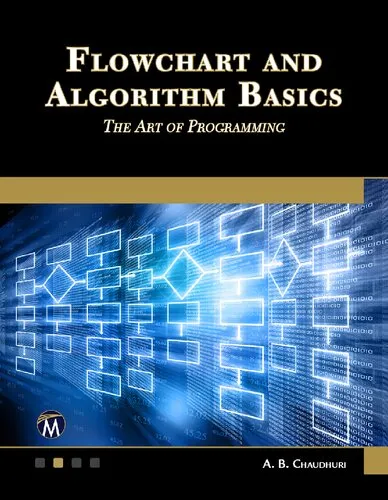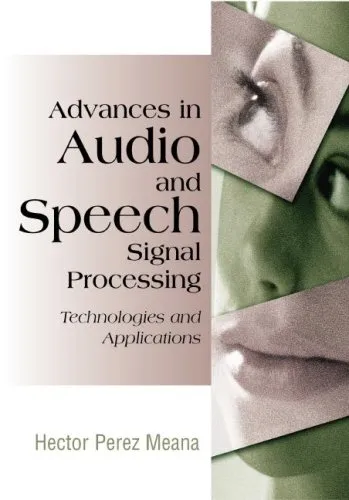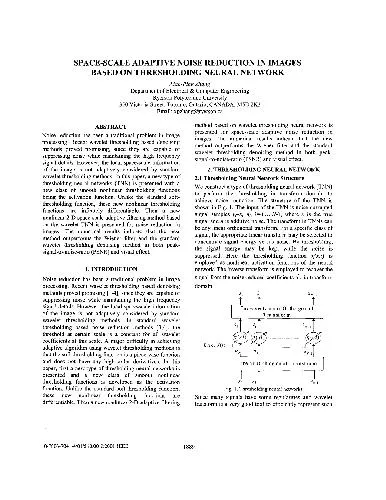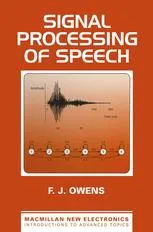Introduction to Digital Speech Processing (Foundations and Trends in Signal Processing)
4.5
بر اساس نظر کاربران

شما میتونید سوالاتتون در باره کتاب رو از هوش مصنوعیش بعد از ورود بپرسید
هر دانلود یا پرسش از هوش مصنوعی 2 امتیاز لازم دارد، برای بدست آوردن امتیاز رایگان، به صفحه ی راهنمای امتیازات سر بزنید و یک سری کار ارزشمند انجام بدینکتاب های مرتبط:
معرفی کتاب "Introduction to Digital Speech Processing"
کتاب "Introduction to Digital Speech Processing" یکی از منابع جامع و کاربردی در زمینه پردازش دیجیتال گفتار (Digital Speech Processing) است که توسط Lawrence R. Rabiner و Ronald W. Schafer به نگارش درآمده است. این اثر، با تمرکز بر مفاهیم بنیادی و کاربردهای عملی پردازش سیگنالهای گفتار، مخاطبان خود را با اصول اصلی این حوزه علمی آشنا میکند. کتاب به صورت عمیق و دقیق به مسائل مختلف این حوزه پرداخته و به دانشجویان، پژوهشگران و متخصصان صنعت ابزارهای لازم برای پیشبرد دانش و تواناییهایشان در این زمینه را ارائه میدهد.
خلاصهای کامل از کتاب
در این کتاب، نویسندگان تلاش کردهاند تا توضیح دهند که چگونه سیگنالهای گفتار انسان به صورت دیجیتال آنالیز، مدلسازی و پردازش میشوند. از ابتدا، با مفاهیم پایهای مانند ساختار تولید گفتار، اصول تبدیل سیگنالهای گفتاری به دیجیتال و معرفی مدلهای مختلف این حوزه شروع میکند. سپس، تکنیکهای تحلیل مانند Short-Time Fourier Transform (STFT)، ویژگیهای صوتی نظیر Mel-Frequency Cepstral Coefficients (MFCC)، و مدلهای آماری مثل Hidden Markov Models (HMM) برای کاربردهایی مانند تشخیص خودکار گفتار توضیح داده میشوند.
همچنین کتاب به بررسی ابزارها و روشهای لازم برای حذف نویز، بهبود کیفیت گفتار و استخراج اطلاعات مفید از سیگنال گفتار میپردازد. این محتوای غنی نه تنها تئوری بلکه راهنماییهای عملی برای کاربردهای واقعی ارائه میکند.
نکات کلیدی کتاب
- درک اصول بنیادی تولید گفتار انسانی و نقش فیزیولوژی در آن.
- آشنایی عمیق با تکنیکهای متداول در فیلترسازی، نمونهبرداری و دیجیتالسازی سیگنالهای گفتاری.
- مدلسازی سینتتیک و آماری سیگنالهای گفتاری برای تشخیص و سنتز.
- معرفی و تحلیل کاربردهای گسترده پردازش گفتار، از جمله Voice Activity Detection (VAD) و Text-to-Speech Synthesis (TTS).
- تمرکز ویژه بر چالشهای واقعی نظیر نویز محیطی یا تفاوتهای فردی در تولید گفتار.
جملات معروف از کتاب
"Speech is the natural mode of communication among humans, and understanding its digital processing is key to enabling human-machine interactions."
"The intersection of signal processing and linguistics leads to a richer understanding of human communication."
چرا این کتاب مهم است؟
اهمیت این کتاب در جامعیت و زیربنای آموزشی آن نهفته است. برای دانشجویان رشتههای مهندسی برق، علوم کامپیوتر، هوش مصنوعی و زبانشناسی، این کتاب یک راهنمای مستحکم برای ورود به دنیای جذاب پردازش گفتار است. همچنین، برای مهندسانی که در صنعت فناوری صوتی فعالیت میکنند، این اثر به عنوان یک منبع مرجع برای طراحی و توسعه سیستمهای نوین پردازش گفتار به شمار میرود.
با توجه به رشد روزافزون کاربردهای سیستمهای تشخیص گفتار و فرمان صوتی در زندگی روزمره، مانند دستیارهای هوشمند (Siri, Alexa)، نرمافزارهای ترجمه آنلاین و سیستمهای بیومتریک صوتی، یادگیری از این کتاب میتواند الهامبخش نوآوریهای جدید در این زمینه حیاتی باشد.
Introduction to Digital Speech Processing
"Introduction to Digital Speech Processing" is a comprehensive and authoritative resource for understanding the fundamental principles and modern techniques in the field of speech processing. Authored by Lawrence R. Rabiner and Ronald W. Schafer, this book is part of the "Foundations and Trends in Signal Processing" series and serves as an essential guide for students, researchers, and professionals in signal processing, computer science, and linguistics. Crafted for those intrigued by the mechanics of digital speech, this work provides an intricate balance between theory and practical applications, making it a cornerstone for anyone interested in speech and signal processing.
Detailed Summary of the Book
The book dissects the intricate process of speech processing, from understanding fundamental acoustics to implementing complex speech synthesis systems. It begins with an introduction to the human speech production mechanism, exploring how speech is generated, transmitted, and perceived. This physiological perspective lays the groundwork for understanding the digital processing methods discussed later.
Gradually, the text journeys into the coding and representation of speech signals, covering topics like sampling, quantization, and feature extraction techniques such as Mel-Frequency Cepstral Coefficients (MFCCs). These methods are crucial for converting speech into a digital format that can be analyzed and manipulated by computers. The authors emphasize accuracy and efficiency in signal processing, introducing filters, spectral analysis, and basic statistics important for speech signal interpretation.
A significant portion of the text is dedicated to speech compression, recognition, and synthesis—key technologies in speech-based applications today. From phone call compression to voice assistants, these principles power everyday technologies. The authors break down complex ideas such as Linear Predictive Coding (LPC), Hidden Markov Models (HMM), and automatic speech recognition (ASR) techniques into accessible concepts.
The conclusion of the book dives into advanced topics like speaker identification, emotion recognition, and speech enhancement in noisy environments. Rich in diagrams, mathematical formulations, and pseudo-code examples, the book builds a solid bridge between theoretical understanding and applied research. Complemented by historical context and real-world scenarios, this text offers a well-rounded view of the field.
Key Takeaways
- Comprehensive coverage of speech production, acoustic modeling, and digital processing techniques.
- Introduction to core concepts like sampling theory, feature extraction, and spectral analysis.
- Techniques for speech coding, compression, and synthesis in modern applications.
- Detailed explanations of machine learning models such as HMM and their role in speech recognition.
- Emphasis on real-world applications of speech processing, including communication systems and AI-powered assistants.
- An excellent balance between mathematical rigor and practical implementation tips.
Famous Quotes from the Book
"Speech is the most natural form of human communication, and understanding its digital processing is key to bridging human and machine intelligence."
"The elegance of digital speech processing lies in its ability to transform complex vocal signals into intelligible forms for computation."
Why This Book Matters
In today's AI-driven world, speech processing technologies underpin advancements ranging from virtual assistants to automated translation services. "Introduction to Digital Speech Processing" provides the foundational knowledge required to advance in this critical field. As speech interactions increasingly replace traditional input methods in devices and systems, understanding how speech is represented, processed, and synthesized is important not just for scientists and engineers but also for entrepreneurs and decision-makers driving the future of technology.
By presenting the principles of digital speech processing in an accessible yet rigorous manner, this book empowers readers to contribute to the development of innovative applications that make human-computer interaction more intuitive and inclusive. Its focus on both theoretical underpinnings and practical implementations ensures it remains relevant in both academic and industrial contexts. This timeless work continues to inspire advancements in speech-based systems, elevating human communication in every aspect.
دانلود رایگان مستقیم
شما میتونید سوالاتتون در باره کتاب رو از هوش مصنوعیش بعد از ورود بپرسید
دسترسی به کتابها از طریق پلتفرمهای قانونی و کتابخانههای عمومی نه تنها از حقوق نویسندگان و ناشران حمایت میکند، بلکه به پایداری فرهنگ کتابخوانی نیز کمک میرساند. پیش از دانلود، لحظهای به بررسی این گزینهها فکر کنید.
این کتاب رو در پلتفرم های دیگه ببینید
WorldCat به شما کمک میکنه تا کتاب ها رو در کتابخانه های سراسر دنیا پیدا کنید
امتیازها، نظرات تخصصی و صحبت ها درباره کتاب را در Goodreads ببینید
کتابهای کمیاب یا دست دوم را در AbeBooks پیدا کنید و بخرید
1279
بازدید4.5
امتیاز0
نظر98%
رضایتنظرات:
4.5
بر اساس 0 نظر کاربران
Questions & Answers
Ask questions about this book or help others by answering
No questions yet. Be the first to ask!
